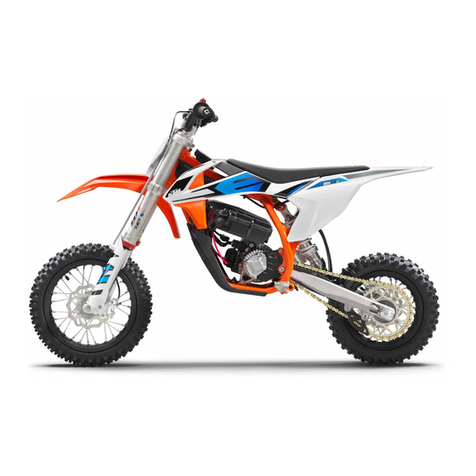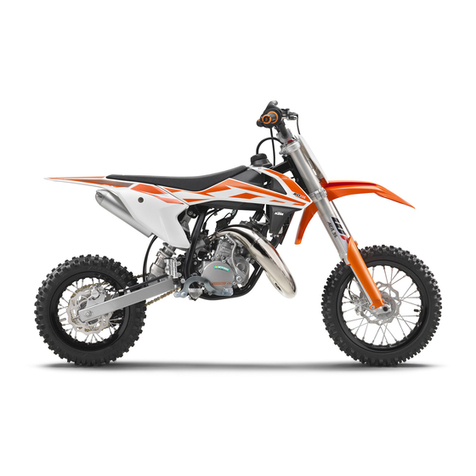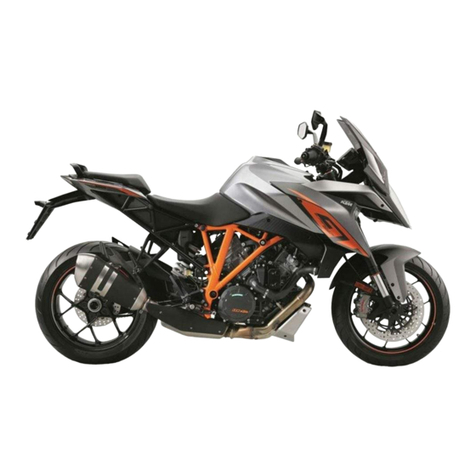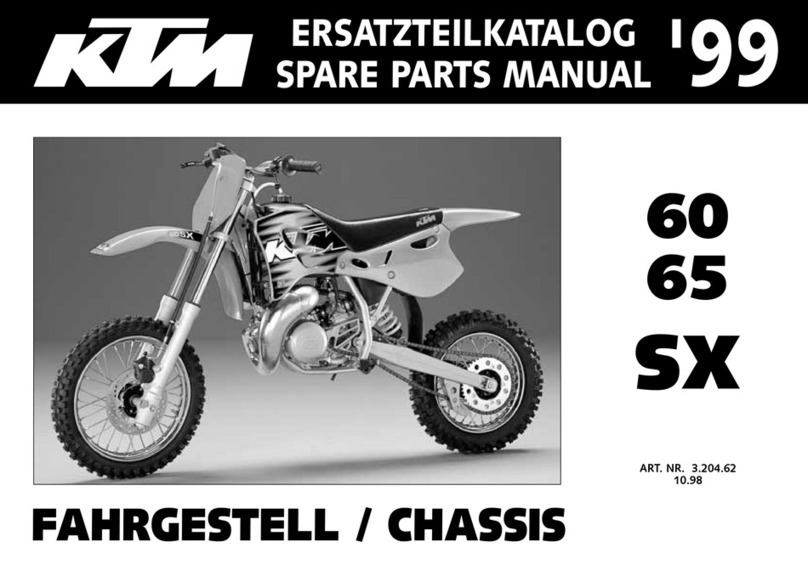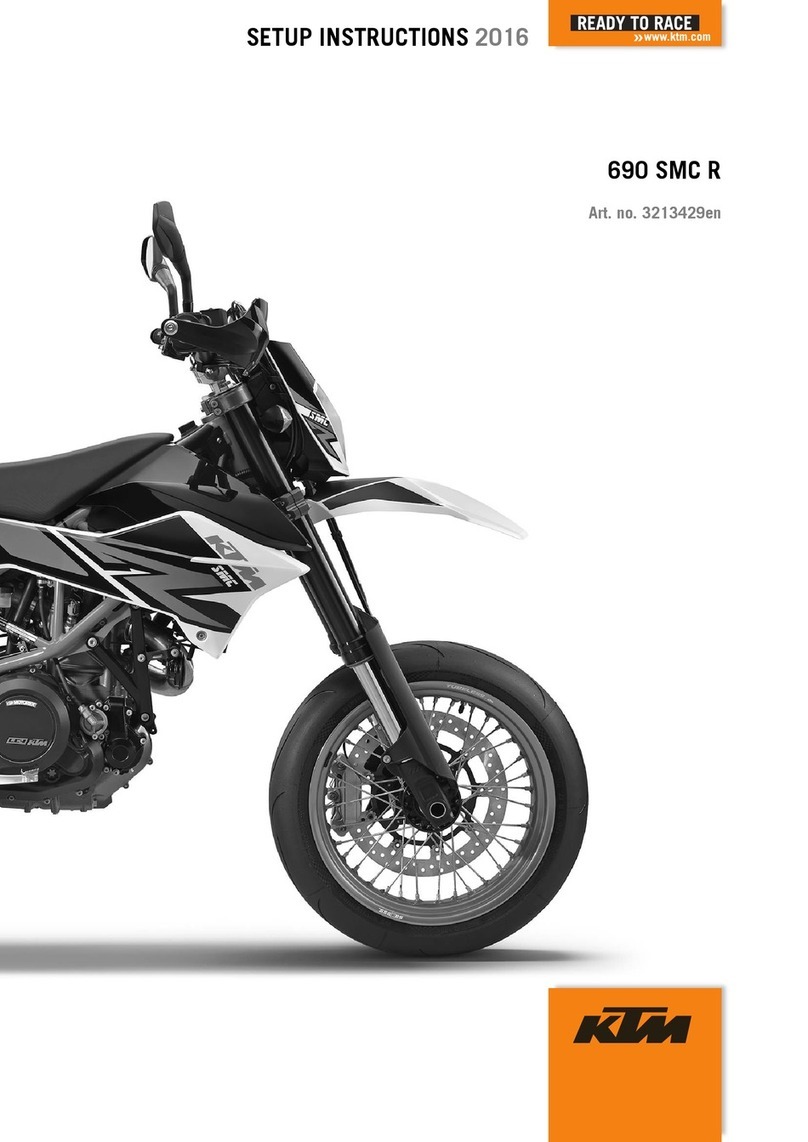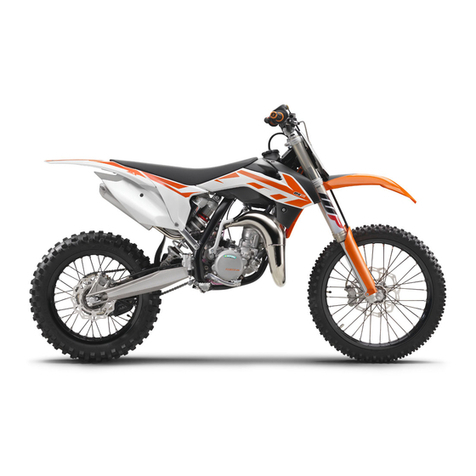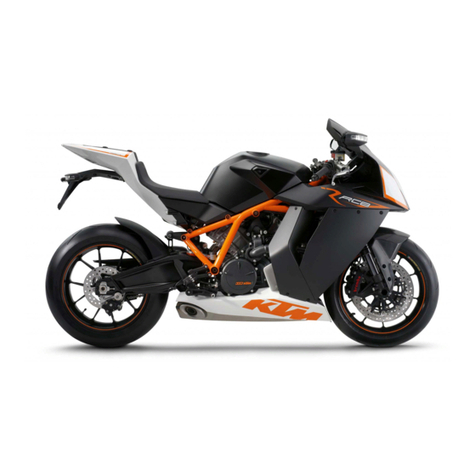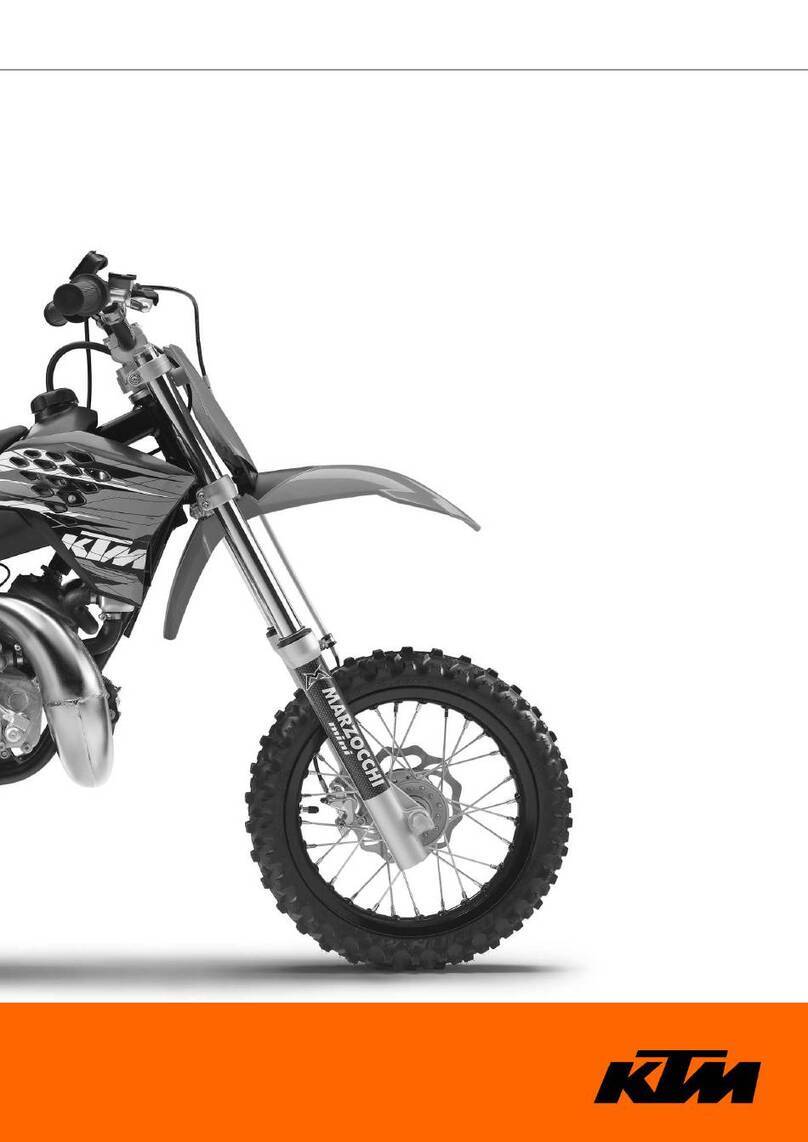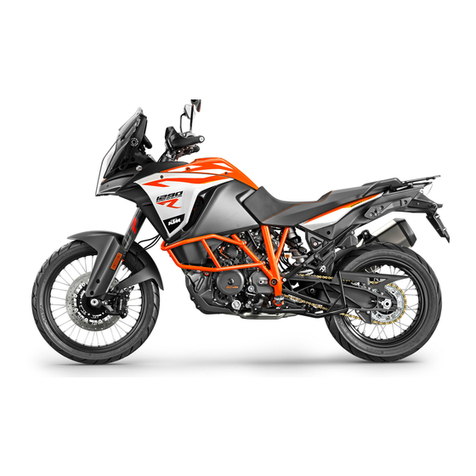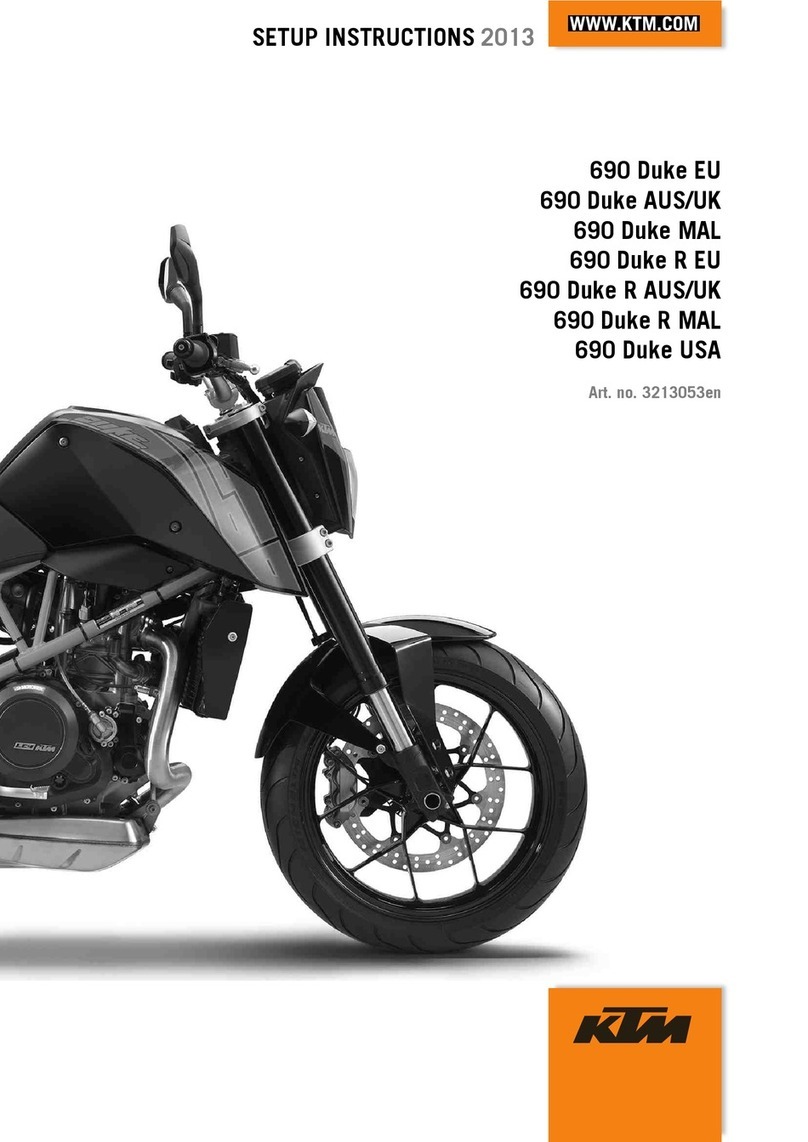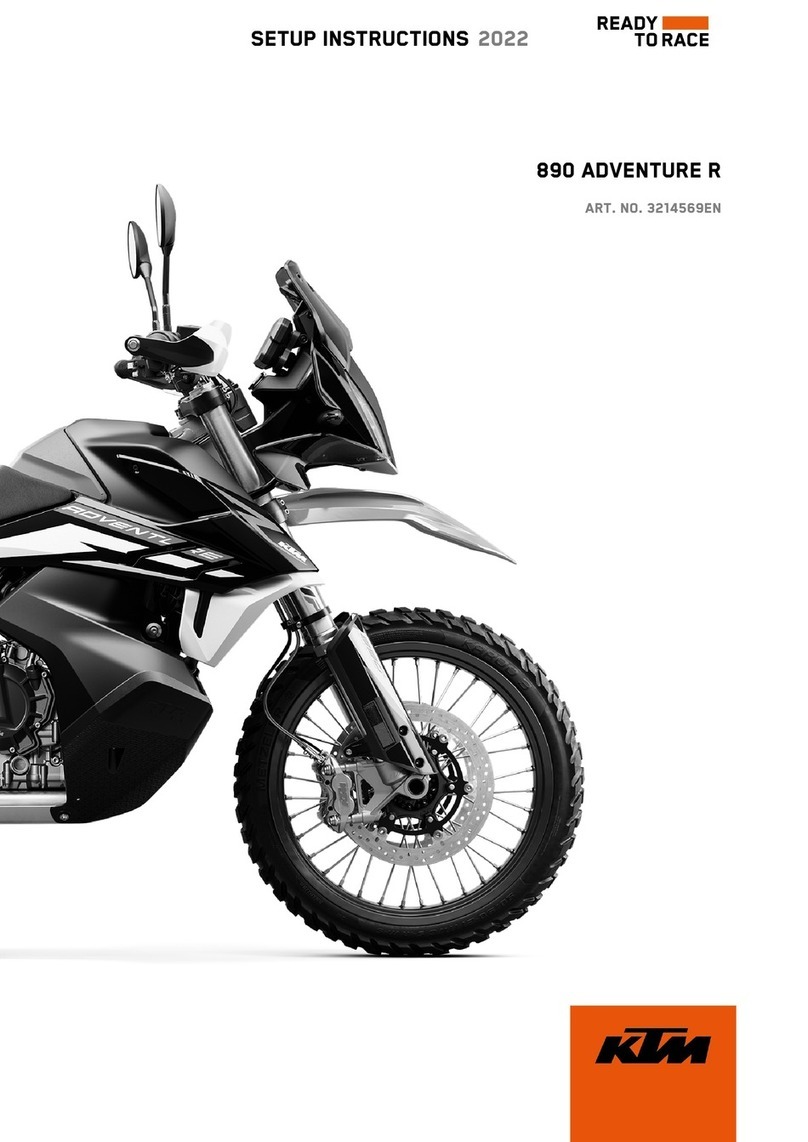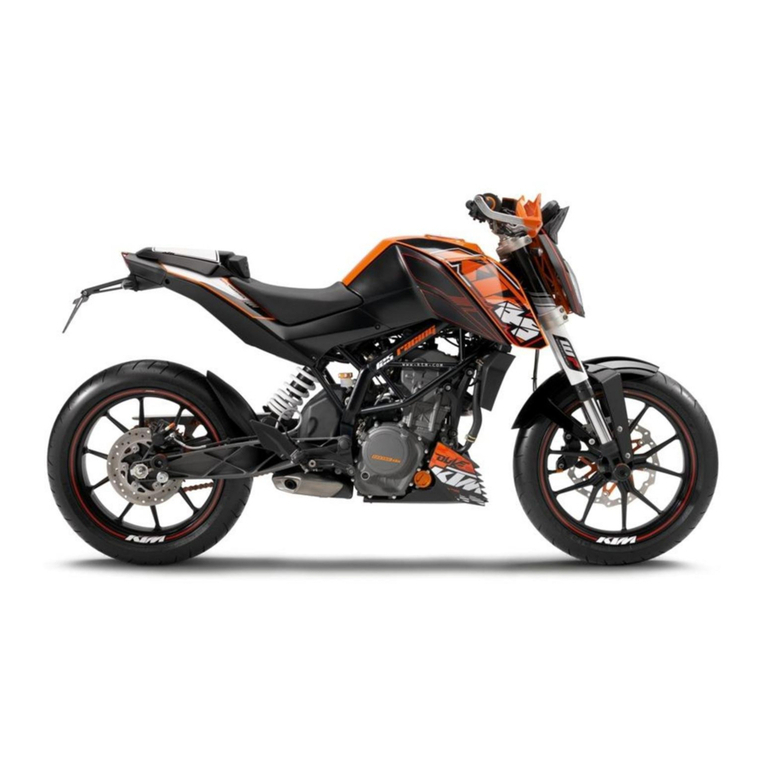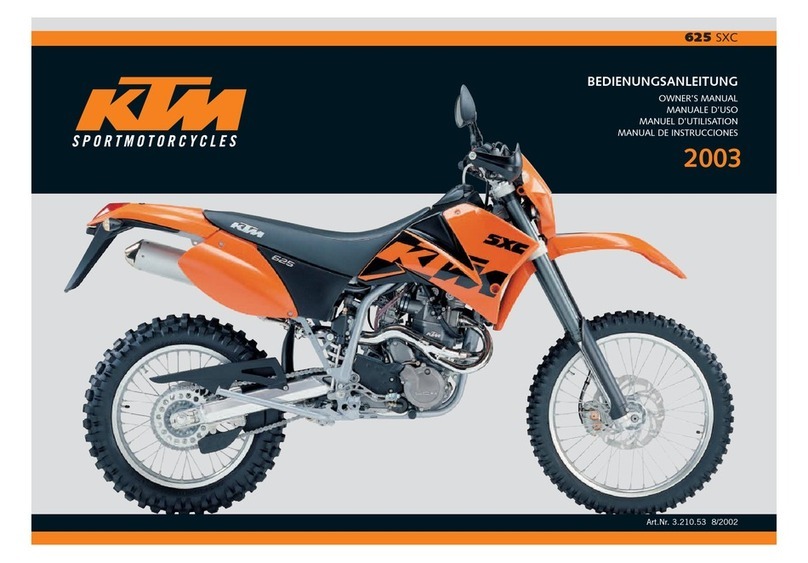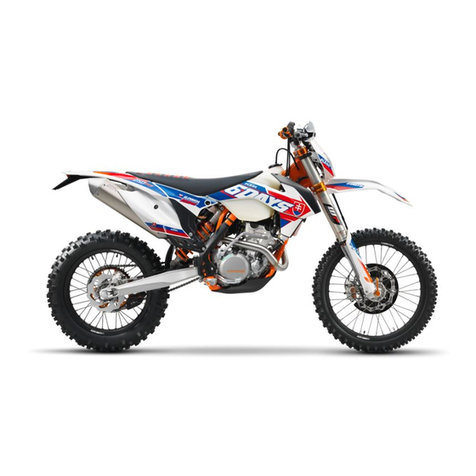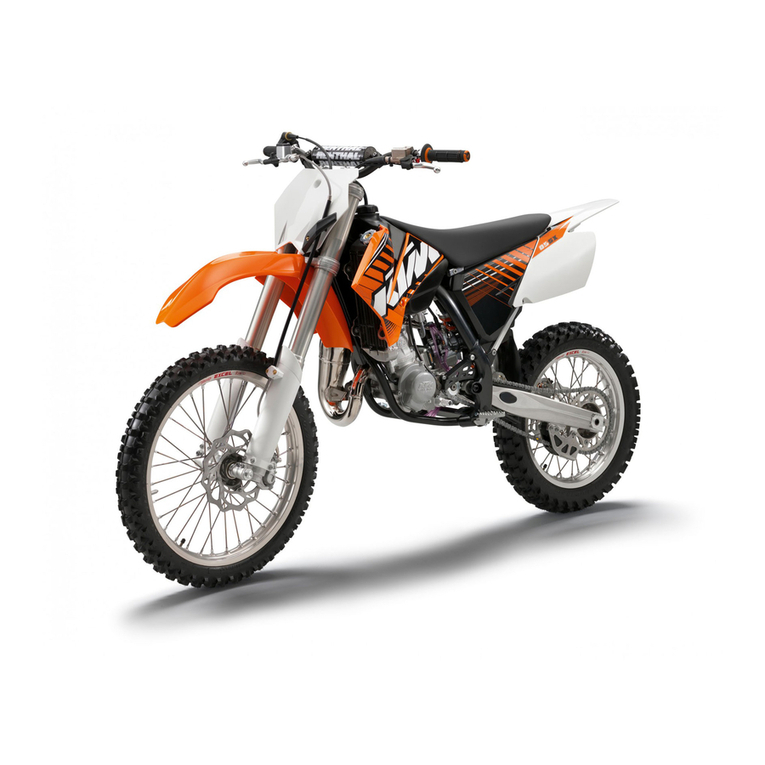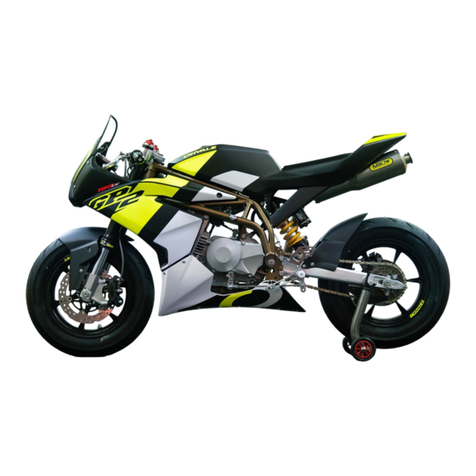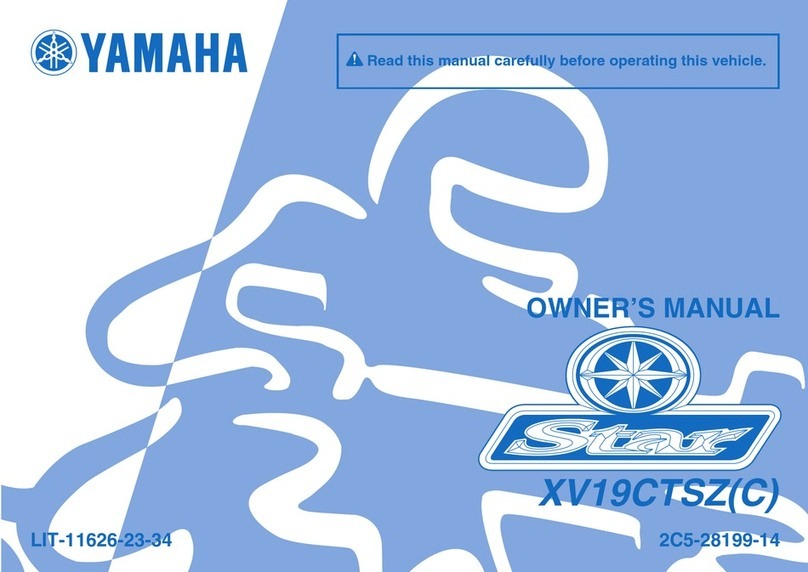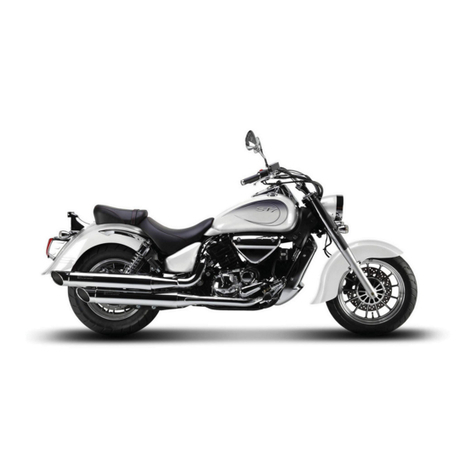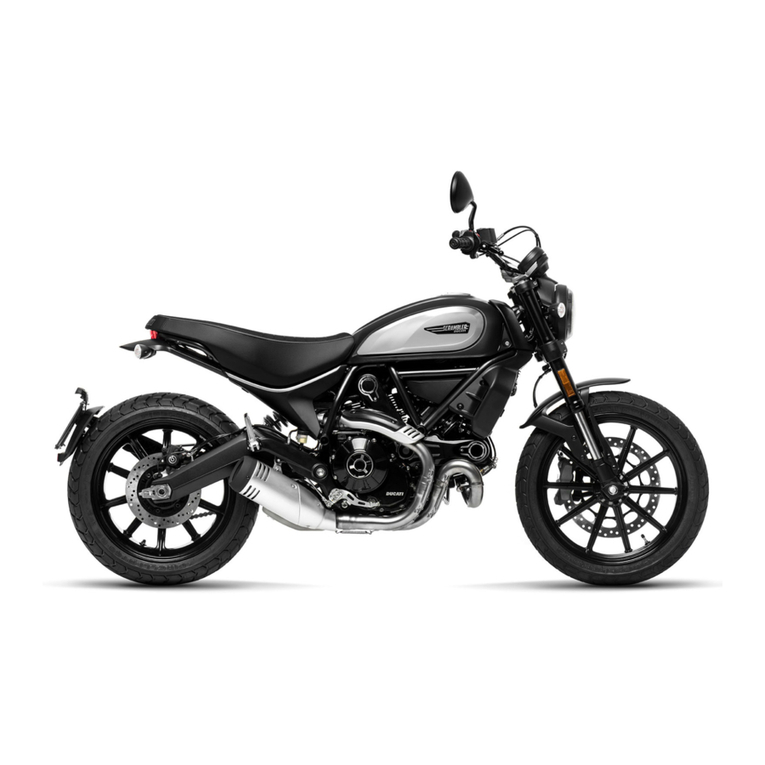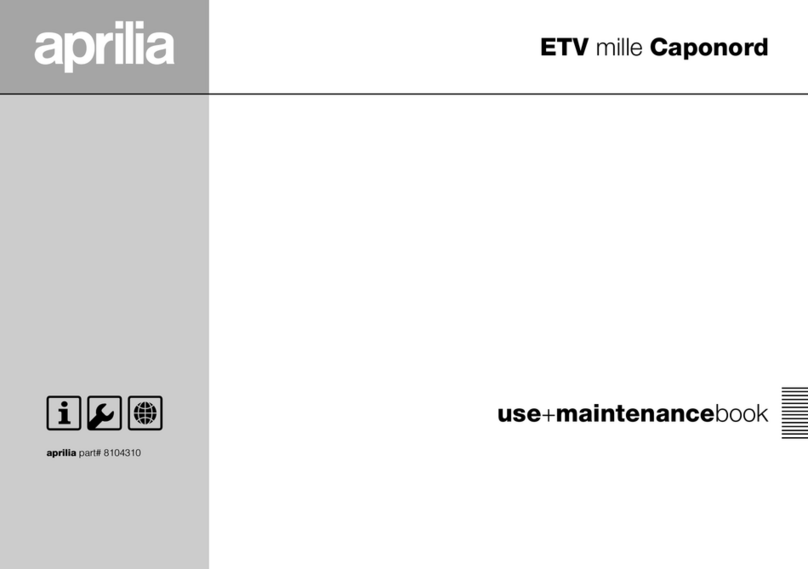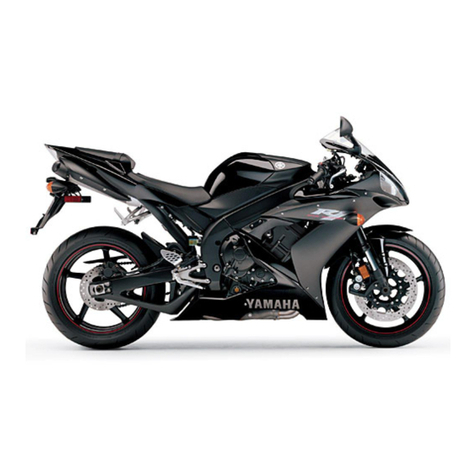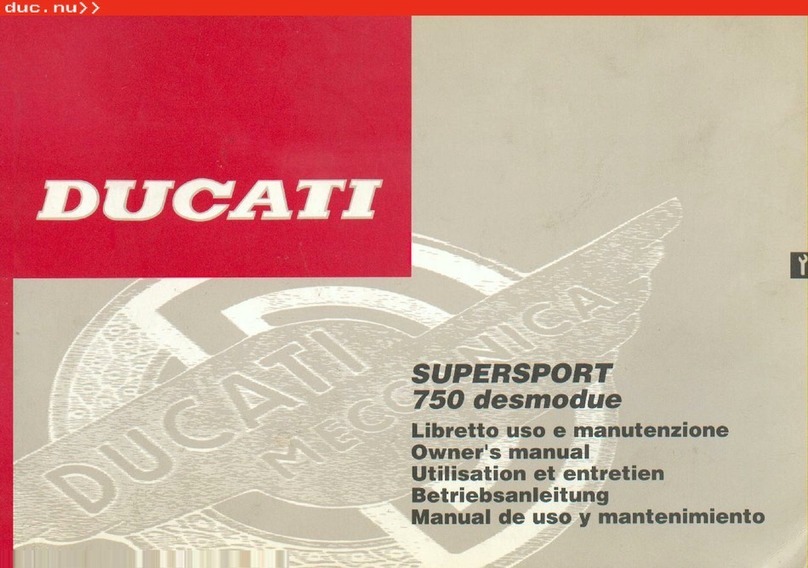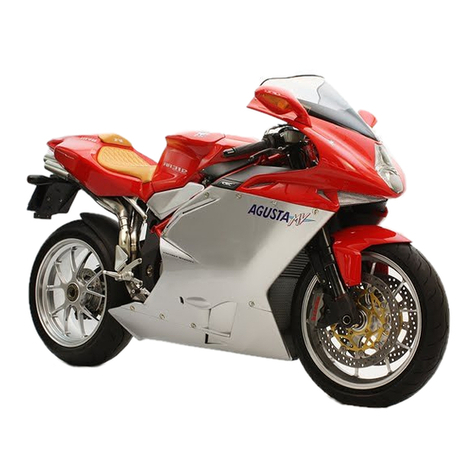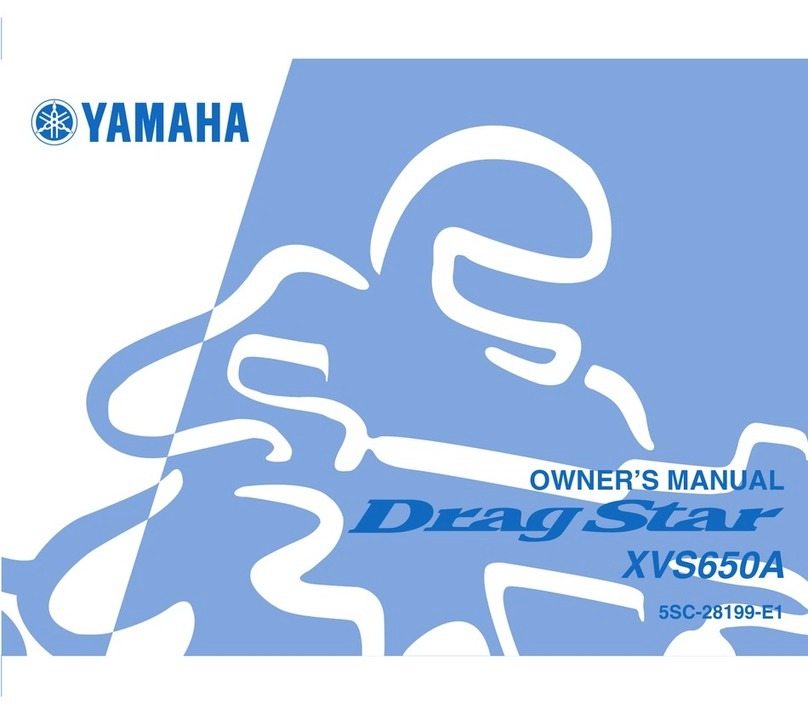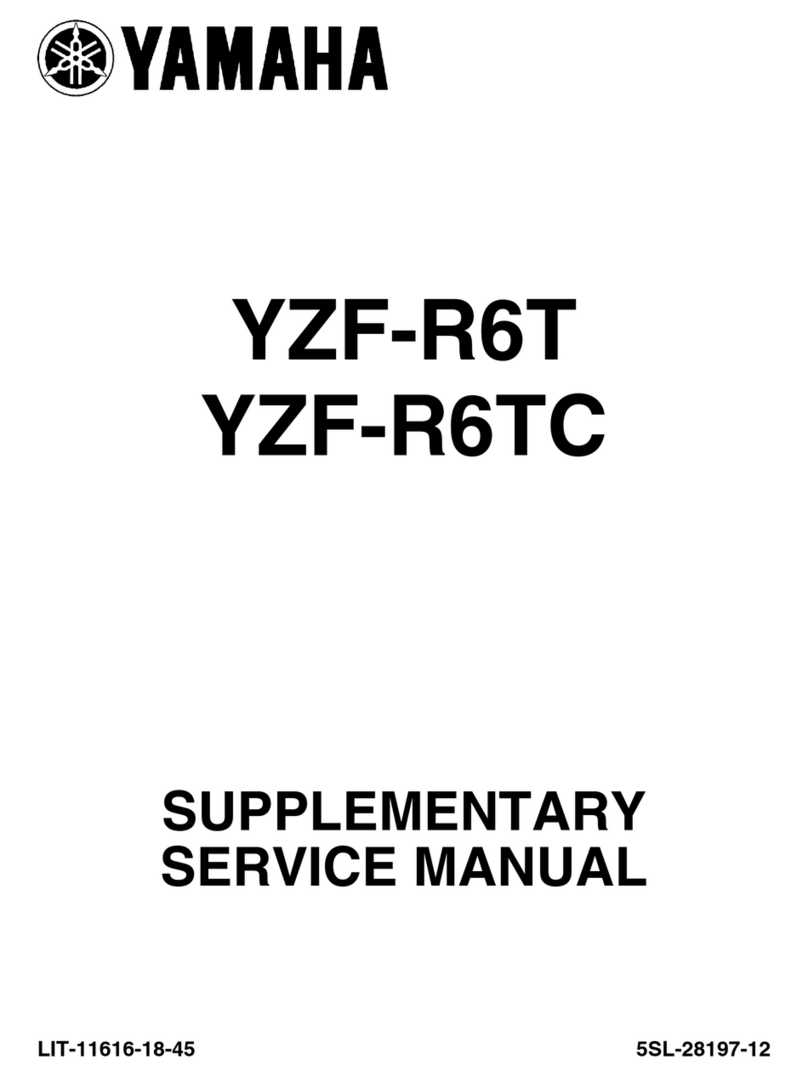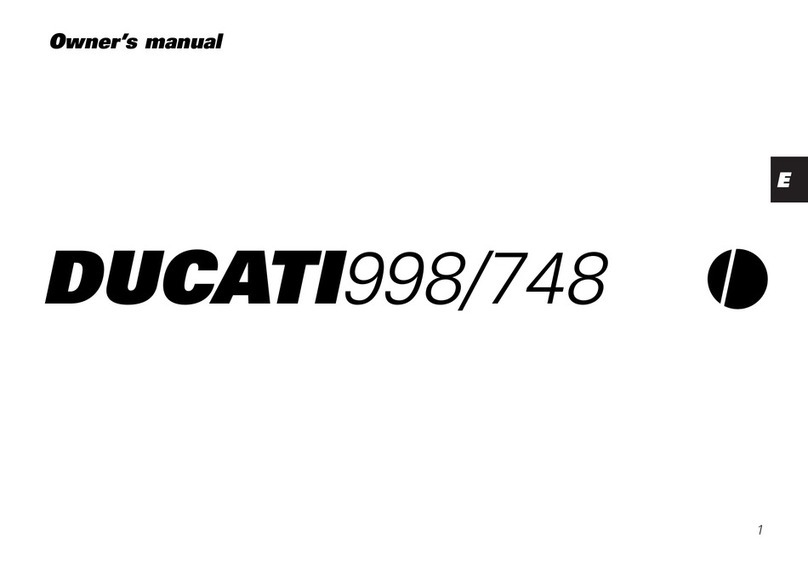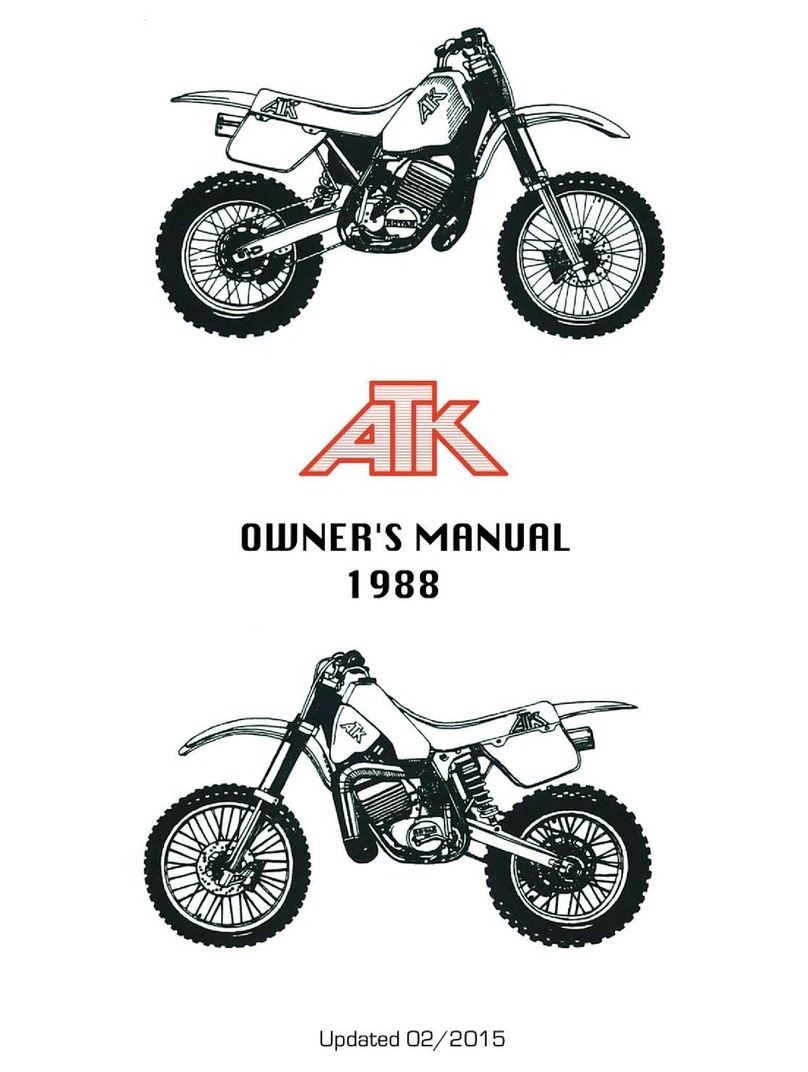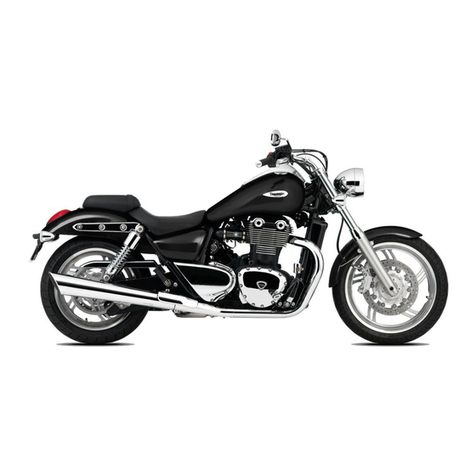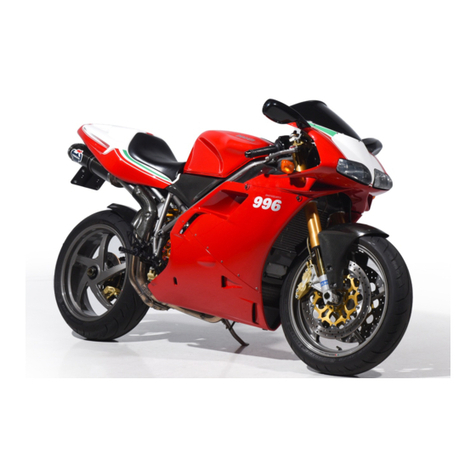ENGLISH
4
Page
Adjusting of free travel at the hand brake lever (SXC) .29
Changing the basic position of the handbrake lever (SMC)
.29
General information about KTM disc brakes . . . . . . . .29
Checking of brake fluid level - front brake . . . . . . . . .30
Refilling the front brake fluid reservoir . . . . . . . . . . .30
Checking the front brake pads (SXC) . . . . . . . . . . . . .31
Checking the front brake pads (SMC) . . . . . . . . . . . .31
Replacing front brake pads (SXC) . . . . . . . . . . . . . . .31
Replacing the front brake pads (SMC) . . . . . . . . . . . .32
Check the rear brake fluid level . . . . . . . . . . . . . . . .32
Refilling the rear brake fluid reservoir . . . . . . . . . . . .32
Changing the basic position of the brake pedal . . . . . .33
Checking the rear brake pads . . . . . . . . . . . . . . . . . .33
Replacing the rear brake pads . . . . . . . . . . . . . . . . .33
Dismounting and mounting the front wheel (SXC) . . . .34
Dismounting and mounting the front wheel (SMC) . . .34
Dismounting and mounting the rear wheel . . . . . . . . .35
Checking the shock absorption rubbers in the rear hub (SMC)
.35
Tires, air pressure . . . . . . . . . . . . . . . . . . . . . . . . . .36
Checking spoke tension . . . . . . . . . . . . . . . . . . . . . .36
Check/set distance of the magnetic sensor . . . . . . . . .36
Battery for digital speedometer . . . . . . . . . . . . . . . . .36
Battery (SXC) . . . . . . . . . . . . . . . . . . . . . . . . . . . . .37
Charging the battery . . . . . . . . . . . . . . . . . . . . . . . .37
Fuses . . . . . . . . . . . . . . . . . . . . . . . . . . . . . . . . . . .38
Replacing headlight lamp/parking light lamp . . . . . . .38
Exchanging the brake light and tail light bulb (SXC) . .39
Exchanging the brake light and tail light bulb (SMC) .39
Checking the coolant level . . . . . . . . . . . . . . . . . . . .40
Cooling system . . . . . . . . . . . . . . . . . . . . . . . . . . . .40
Cleaning the air filter (SXC) . . . . . . . . . . . . . . . . . . .41
Cleaning of air filter . . . . . . . . . . . . . . . . . . . . . . . . .41
Exhaust system (SXC) . . . . . . . . . . . . . . . . . . . . . . .42
Exhaust system (SMC) . . . . . . . . . . . . . . . . . . . . . . .42
Adjusting the throttle cable . . . . . . . . . . . . . . . . . . .43
Checking the adjustment of the hand decompression cable
.43
Changing the original position of the clutch lever . . . .44
Checking the oil level of the hydraulic clutch . . . . . .44
Bleeding of the hydraulic clutch . . . . . . . . . . . . . . . .44
Activating the ignition curve for low-octane fuel . . . . .45
Draining the float chamber of the carburetor . . . . . . .45
CARBURETOR – Adjust idling . . . . . . . . . . . . . . . . .45
Adjusting the mixture control screw . . . . . . . . . . . . .46
Checking the float level (float height) . . . . . . . . . . . .46
Engine oil . . . . . . . . . . . . . . . . . . . . . . . . . . . . . . . .46
Checking the engine oil level . . . . . . . . . . . . . . . . . .46
Oil circuit . . . . . . . . . . . . . . . . . . . . . . . . . . . . . . . .47
Oil and screen filter change, bleeding of the oil system
.47
Changing oil filter . . . . . . . . . . . . . . . . . . . . . . . . . .48
TROUBLE SHOOTING . . . . . . . . . . . . . . . . . . . . . . . . .49
CLEANING . . . . . . . . . . . . . . . . . . . . . . . . . . . . . . . . .51
CONSERVATION FOR WINTER OPERATION . . . . . . . . . .51
STORAGE . . . . . . . . . . . . . . . . . . . . . . . . . . . . . . . . . .51
Reinitiation after time of storage . . . . . . . . . . . . . . . .51
TECHNICAL SPECIFICATIONS – ENGINE . . . . . . . . . . .52
Engine oil . . . . . . . . . . . . . . . . . . . . . . . . . . . . . . . .52
TECHNICAL SPECIFICATIONS - CHASSIS . . . . . . . . . . .54
HEAD WORD INDEX . . . . . . . . . . . . . . . . . . . . . . . . . .56
WIRING DIAGRAM . . . . . . . . . . . . . . . . . . . . . . .appendix
Page
IMPORTANT LIMITED WARRANTY AND LIMITED
GUARANTEE INFORMATION . . . . . . . . . . . . . . . . . . . . .3
SERIAL NUMBER LOCATIONS . . . . . . . . . . . . . . . . . . . .5
Chassis number . . . . . . . . . . . . . . . . . . . . . . . . . . . .5
Engine number, engine type . . . . . . . . . . . . . . . . . . . .5
OPERATION INSTRUMENTS . . . . . . . . . . . . . . . . . . . . .6
Clutch lever . . . . . . . . . . . . . . . . . . . . . . . . . . . . . . .6
Hand decompression lever . . . . . . . . . . . . . . . . . . . . .6
Hand brake lever (SXC) . . . . . . . . . . . . . . . . . . . . . . .6
Hand brake lever (SMC) . . . . . . . . . . . . . . . . . . . . . . .6
Indicator lamps . . . . . . . . . . . . . . . . . . . . . . . . . . . . .6
Electronic speedometer . . . . . . . . . . . . . . . . . . . . . . .7
Overview of the electronic speedometer functions . . .11
Ignition lock . . . . . . . . . . . . . . . . . . . . . . . . . . . . . .12
Combination switch . . . . . . . . . . . . . . . . . . . . . . . . .12
Flasher switch . . . . . . . . . . . . . . . . . . . . . . . . . . . . .12
Emergency OFF button . . . . . . . . . . . . . . . . . . . . . .12
Filler cap . . . . . . . . . . . . . . . . . . . . . . . . . . . . . . . .12
Fuel tap . . . . . . . . . . . . . . . . . . . . . . . . . . . . . . . . .13
Choke . . . . . . . . . . . . . . . . . . . . . . . . . . . . . . . . . .13
Hot start device . . . . . . . . . . . . . . . . . . . . . . . . . . . .13
Shift lever . . . . . . . . . . . . . . . . . . . . . . . . . . . . . . .13
Kickstarter . . . . . . . . . . . . . . . . . . . . . . . . . . . . . . .13
Foot brake pedal . . . . . . . . . . . . . . . . . . . . . . . . . . .14
Handlebar lock . . . . . . . . . . . . . . . . . . . . . . . . . . . .14
Compression damping of fork . . . . . . . . . . . . . . . . . .15
Rebound damping of fork . . . . . . . . . . . . . . . . . . . . .15
Compression damping of shock absorber . . . . . . . . . .15
Rebound damping of shock absorber . . . . . . . . . . . . .15
GENERAL TIPS AND WARNINGS FOR STARTING THE
MOTORCYCLE . . . . . . . . . . . . . . . . . . . . . . . . . . . . . .16
Instructions for initial operation . . . . . . . . . . . . . . . .16
Running in the LC4 models . . . . . . . . . . . . . . . . . . .16
Accessories and payload . . . . . . . . . . . . . . . . . . . . .16
DRIVING INSTRUCTIONS . . . . . . . . . . . . . . . . . . . . . .17
Check the following before each start . . . . . . . . . . . .17
Starting when the engine is cold . . . . . . . . . . . . . . . .18
Starting when the engine is warm or hot . . . . . . . . . .18
What to do when the engine is “flooded” . . . . . . . . . .18
Kickstart instructions . . . . . . . . . . . . . . . . . . . . . . . .18
Starting off . . . . . . . . . . . . . . . . . . . . . . . . . . . . . . .18
Shifting/Riding . . . . . . . . . . . . . . . . . . . . . . . . . . . .19
Stopping and parking . . . . . . . . . . . . . . . . . . . . . . . .19
Braking . . . . . . . . . . . . . . . . . . . . . . . . . . . . . . . . .19
Fuel . . . . . . . . . . . . . . . . . . . . . . . . . . . . . . . . . . . .20
PERIODIC MAINTENANCE SCHEDULE . . . . . . . . . . . . .21
MAINTENANCE WORK ON CHASSIS AND ENGINE . . . .23
Removal of seat (SXC) . . . . . . . . . . . . . . . . . . . . . . .23
Tool set (SXC) . . . . . . . . . . . . . . . . . . . . . . . . . . . . .23
Removal of seat (SMC) . . . . . . . . . . . . . . . . . . . . . .24
Tool set (SMC) . . . . . . . . . . . . . . . . . . . . . . . . . . . .24
Check and adjust steering head bearing . . . . . . . . . . .24
Breather plug front fork . . . . . . . . . . . . . . . . . . . . . .25
Cleaning the dust sleeves of the telescopic fork . . . . .25
How to change the handlebar position . . . . . . . . . . . .25
Changing the spring preloading of the shock absorber .26
Checking rubber ring on the WP rear shock absorber . .26
Lubricate rear suspension linkage . . . . . . . . . . . . . . .26
Correct chain tension . . . . . . . . . . . . . . . . . . . . . . . .27
Checking chain tension . . . . . . . . . . . . . . . . . . . . . .27
Chain wear . . . . . . . . . . . . . . . . . . . . . . . . . . . . . . .28
Chain maintenance . . . . . . . . . . . . . . . . . . . . . . . . .28
INDEX »
